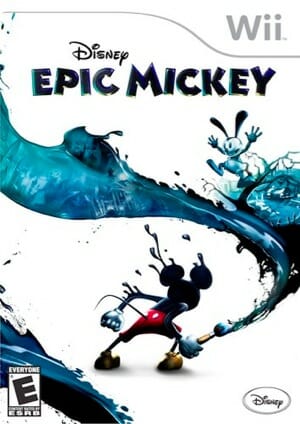The idea of a Mickey Mouse game seems so Mickey Mouse. The character has been around for decades, but recently everything that once seemed so interesting about the bipedal rodent has been scrubbed away in favor of a bland brand—perpetually shirtless, yet completely innocuous. The idea that someone could make Mickey intriguing again—especially for non-children—seems so far-fetched as to be impossible, and the idea of a Mickey game appealing to anyone but pre-critical tots sounds highly suspicious, especially coming from Disney itself.
It’s all Mickey’s fault, that rat bastard. During a deleted scene from “Fantasia,” he spills thinner on the sorcerer’s map, unleashing an ink-black tidal wave that erases bits and pieces of the world within the sketch. Years later, Mickey is sucked into this half-corroded world, and must use a magical paintbrush to paint in the holes or thin out the landscape to discover hidden clues. It’s custom-built for the Wii: No other console gives players that sort of painterly control.
This ruined theme park is a fascinating place, a world of detritus and debris, fit for a feature film but also perfect for gameplay, as it sets up intriguing obstacles and puzzles for Mickey to solve. In one scene, Mickey must repair the It’s a Small World boat ride; in another, he scales a mountain of torn Mickey comics, old Nintendo games, and broken toys—a pop culture landfill that hints at the disposability of the franchise.
One of the most intriguing aspects of Epic Mickey are the side-scrolling levels that connect one world to the next. They’re metafictional wormholes rendered as old Disney cartoons, such as Steamboat Willie or Plutopia. It’s ingenious and, better yet, actually fun as the retro 2D contrasts spatially with the modern 3D.
Few games, no matter how graphically advanced or story-oriented, create such vivid, imaginative, and—yes—subversive worlds, yet that thoughtfulness does not extend to the game itself, which can be convoluted, repetitive, and tedious. Painting and thinning the scenery can be a blast, especially since Epic Mickey encourages exploration. But the controls can be cumbersome, and the camerawork so awkward as to induce nausea. The button for re-centering the camera rarely ever works, which leaves players manually scrolling around just to orient themselves.
As Epic Mickey proceeds, the character collects new abilities and new allies, including Guardians—floating blue or green dots that have little use within the game. They’re really just a distraction, something else to keep track of but with little payoff in actual gameplay. Likewise, the status displays are more confusing than clarifying, leaving players with little idea of where they stand on the multitude of tasks and assignments they’ve taken on. There’s an inordinate amount of errand running: You need one character to give you a gear for a projector screen, but he wants his book back. The character who has the book wants something else in return, which involves too much running from one house to another.
That these flaws are so minor—and seemingly so avoidable—only makes them more egregious and intrusive. With Epic Mickey, Disney has created a darkly evocative, often visually stunning world, yet interacting with it is not always easy or natural. Hopefully such shortcomings can be solved in the inevitable and certainly welcome sequel.
